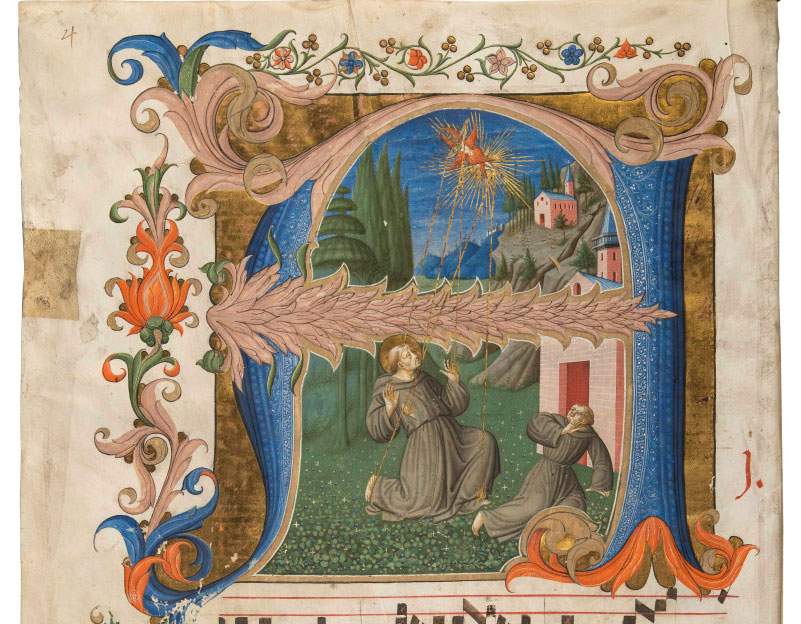New arrangement for Michelozzo’s Monumental Library: the San Marco Museum in Florence re-exposes after a long time the Missal of St. Dominic by Beato Angelico and twelve Franciscan illuminated codices from five different provenances. In the rearrangement that is the result of a recent and rigorous study by historian of miniatures Ada Labriola, from Saturday, May 22, 2021, the Missal illuminated by the famous artist will be visible to the public for no more than a year, while the Dominican choir books from the previous display will be put to rest in the cabinets of the adjoining Sala Greca.
“The replacement of the codices on display in Michelozzo’s Library, dictated primarily by preservation needs,” stress Stefano Casciu, regional director Museums of Tuscany, and Angelo Tartuferi, director of the Museo di San Marco, "will allow the public to discover another unknown page in the museum’s collection of illuminated manuscripts and will offer a truly rare opportunity to admire Codex 558, one of the masterpieces of early 15th-century Italian illumination."
The Monumental Library was built by Michelozzo at the behest of Cosimo il Vecchio de’ Medici as a public library, thus intended not only for the friars of the convent, but also for all scholars, including lay people. It includes an extraordinary collection of 15th-century illuminated codices, some illustrated by Beato Angelico and his collaborators. Every three years, a selection of the collection of illuminated liturgical manuscripts is displayed in the showcases in rotation.
Beato Angelico’s chorale (actually a gradual) was made between 1424 and 1430, probably for San Domenico in Fiesole, the convent to which the friar painter belonged and which represents the oldest and most important evidence of his work as an illuminator. Later transferred to the estate of Grand Duchess Maria Antonia, wife of Leopold II of Lorraine, it passed to the National Library of Florence and from there, in 1869, to the Museum of San Marco. The public will be able to see the codex open to the card illustrating the Glory of St. Dominic in the superbly historiated initial “I”: at the base the two founders of the mendicant orders St. Francis and St. Dominic are depicted in affectionate embrace. The miniature celebrates the feast dedicated to the founder of the order of St. Dominic, whom we see in the upper margin inside a gilded mandorla carried in glory by eight musician angels. From the ends of the initial “I” come out vines framing some of the saints particularly venerated by the Dominican order, including the father and Doctor of the Church St. Thomas Aquinas.
Until Aug. 3, every Tuesday, visitors can also access the Cloister of San Domenico, originally decorated with thirty-six fresco lunettes depicting the stories of St. Dominic created by Baroque Florentine painters such as Cosimo Ulivelli, Alessandro Gherardini, Sebastiano Galeotti, and Niccolò Lapi. In the center of the cloister is a sculptural group by Andrea Baratta of Carrara, depicting St. Dominic trampling heresy, from 1700.
The twelve illuminated chorals on display, from five different provenances, are part of a Franciscan nucleus of twenty-two chorals that came to the Museum of San Marco on several occasions following the Savoy suppressions of 1866. On that occasion, St. Mark’s library holdings, by then depleted over the centuries, were implemented with the arrival of numerous liturgical codices from various convents in and around Florence. The chorals, all referable to illuminators probably from the area of the Franciscan convent of San Salvatore al Monte alle Croci, where an important scriptorium was active between the 15th and 16th centuries, came from convents that adhered to the Observance.
The reform movement promoted a return to the observance of the Rule of Francis, to the rigor and poverty of life practiced by the holy founder, in opposition to the oldest branch of the Order, the Conventual friars.
“A common thread runs through the manuscripts’ sober illustrative furnishings,” Ada Labriola explains, “the rejection of sumptuousness and ostentation, which the Observant friars promoted in the life of the friaries, found a conscious reflection in the iconographic and figurative choices that inspired their illuminated chorals.”
The Franciscan Observance chorals in the Museum of St. Mark’s are of Florentine production and cover almost a century: from the oldest codex, dated 1438, to the most recent one signed in 1526. Their illustrative apparatus thus makes it possible to retrace one of the most debated and complex periods of the miniature in Florence, between the 15th and 16th centuries.
Also continuing on the museum’s YouTube channel every Thursday is the video review Beato Angelico seen by... dedicated to the Dominican artist’s masterpieces on display in the new Beato Angelico Room, created thanks to funding from the Friends of Florence association.
Image: Battista di Niccolò da Padova, initial A with Saint Francis receiving the stigmata, detail from the Antiphonary ms.-584-c.-2v.
 |
| Florence, Michelozzo's Monumental Library rearranged: beato Angelico's missal on display |
Warning: the translation into English of the original Italian article was created using automatic tools. We undertake to review all articles, but we do not guarantee the total absence of inaccuracies in the translation due to the program. You can find the original by clicking on the ITA button. If you find any mistake,please contact us.